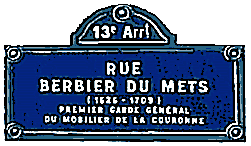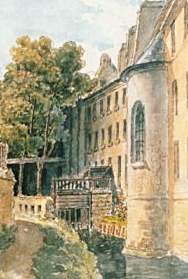|
|
|
Tapestries hold their value because they are so painstaking to produce the sort of
artistic endeavor that makes perfect sense only for a monarchy with unlimited funds, time,
and craftsmen.
You first need an artist to sketch the design and a painter to turn that
sketch into an oil that is the same size as the tapestry. Skilled masters then weave the
tapestries using silk, wool, and sometimes gold or silver threads.
But above all you need patience because it will take a good weaver an entire day to
weave a surface about the size of the human hand
The term "Goblins" applies today indifferently to all kinds of tapestry.
They can as well be Low wrap Tapestries, High ones, Tapestry made with Jacquard mechanics
or of Tapestries stitched with needle named in US needlepoint. In these pages we present
to you the history of the manufacture which gave its name to the Tapestry and specify what
one understands by High wrap and Low wrap.
|
|
GOBELINS MANUFACTURE (said Goblins)
 is a famous establishment of weaved tapestries and dyeing located in Paris,
between the Gobelins avenue, the Croulebarbe street and the Bièvre brook.
is a famous establishment of weaved tapestries and dyeing located in Paris,
between the Gobelins avenue, the Croulebarbe street and the Bièvre brook.
The "Gobelins" were a Champagne's area family originating from
Reims, its capital city. In the XVth century, they was establishing a
 company of dye in the Saint Marceau quater in Paris; Gilles Gobelin grows rich
in this industry and acquired great properties on the edges of the
Bièvre, that one called of his name "Gobelins's river" JEAN GOBLIN dyer,
settled about 1440 in this green small valley where flow the Bièvre
between Butte-aux-Cailles and the Sainte-Geneviève mountain. In 1601
Henri IV installed there two Flemish tapestries makers. But it is especially
Louis XIV who gave a considerable impulse while creating in 1667 the royal
manufacture of furniture of the Crown. Colbert centralized various workshops of
tapestry dispersed in Paris, added workshops of cabinet maker, of goldsmithery
et cætera.
company of dye in the Saint Marceau quater in Paris; Gilles Gobelin grows rich
in this industry and acquired great properties on the edges of the
Bièvre, that one called of his name "Gobelins's river" JEAN GOBLIN dyer,
settled about 1440 in this green small valley where flow the Bièvre
between Butte-aux-Cailles and the Sainte-Geneviève mountain. In 1601
Henri IV installed there two Flemish tapestries makers. But it is especially
Louis XIV who gave a considerable impulse while creating in 1667 the royal
manufacture of furniture of the Crown. Colbert centralized various workshops of
tapestry dispersed in Paris, added workshops of cabinet maker, of goldsmithery
et cætera.
To the 18th century, the name of the Gobelins was known in the Royal court
of whole Europe. The 19th century saw a part of the buildings set fire to by the
Commune revolution in 1871. It is necessary to walk round the manufacture by the
street Croulebarbe and to reach the street "Berbier du Mets", to see
there building supposedly the former in the 17th century. Manufacture continues
today to produce tapestries for the "State-owned-furniture", making
work of contemporary artists. But like to the origin, a workman weaving on a
trade of high wrap (the loom is vertical) make one square metre of tapestry in
one year.
Page d'accueil - Tell me more
|
|
|